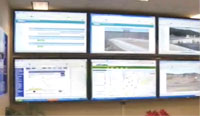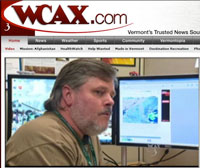Best Practices for Road Weather Management
Vermont Agency of Transportation: Transportation Operations Center
The Vermont Agency of Transportation (VTrans) Transportation Operations Center (TOC) is the focal point for VTrans’ Intelligent Transportation Systems (ITS) road weather management and traveler information systems operations. TOC staff are responsible for monitoring various ITS devices statewide, communicating with VTrans’ road crews, public safety (state and local), and emergency providers via radio and telephone, and updating the general and traveling public via Condition Acquisition Reporting System (CARS). TOC staff input information into CARS and CARS disseminates the information out to the public via 511, Variable Message Signs (VMS), Low Power Frequency Modulation (LPFM) stations, web, e-mail, and text notifications.

Figure VT-1. Traffic operations center.
Figure VT-2. Traffic operations center’s Gregory Fox, VTrans’ communications specialist.
Figure VT-3. Traffic operations center Mark Gerrish, VTrans’ fiber optic project manager.
System Components: The TOC consists of:
- Two Communications Specialists
- Internet Protocol (IP)-based Radio System that connects to all nine VTrans’ districts as well Vermont State Police Dispatch and local police.
- Video Wall for displaying data and video feeds from RWIS, local news, as well as different websites including 511.
System Operations: The TOC relies on various ITS devices such as RWIS, VMS, 511, and LPFM (Low-Power FM).
The TOC has improved VTrans traveler information dissemination as well as winter road maintenance by providing VTrans’ maintenance crews with advanced weather information to allow crews to be proactive versus reactive to road and weather conditions throughout the state. This advanced weather information is ascertained by TOC crews monitoring National Oceanographic and Atmospheric Administration (NOAA), National Weather Service (NWS), as well as local radar to see what types of weather patterns are heading toward Vermont. In addition they provide RWIS data to Lyndon State College Meteorology Department (LSC). LSC takes the data and inputs it into their computer models to analyze the data and provide accurate forecasts to the VTrans districts and 24 to 48 hour advanced weather forecasts.
Transportation Outcome(s): The TOC, though small and undermanned, has provided a wealth of information to VTrans’ maintenance crews and the travelling public regarding adverse driving conditions during the winter, lane and road closures during road construction projects, and road closures due to crashes. VTrans’ maintenance crews heavily rely on feedback from TOC staff as they monitor RWIS data and camera images, NOAA, NWS, and local weather radar, etc. This gives the maintenance crews more time to plan on winter maintenance activities versus waiting for the event to happen and then having to react. Crews can have trucks loaded with correct materials (salt, sand, de-icing, etc.) and in some cases pre-treat roads before winter events occur. The immediate benefit is less material wasted along with man-hours for having to return to the garage to change out materials due to changes in the weather patterns.
The travelling public and local media (TV and radio) have come to rely on 511 (both phone and web) and the various information disseminated. VTrans receives constant feedback (both positive and negative) from the public on how well the systems are working and how the information is used to make their travel more pleasant and feasible.
Implementation Issues: As with all new technology, implementation issues that have affected the TOC the most are reliability issues with ITS devices. VTrans relies heavily on the technology vendors to maintain and troubleshoot problems with the ITS devices. When an ITS device goes down, it may take the vendor a week or more to troubleshoot and fix. While the device is down, TOC staff cannot receive or review data from the device. This creates holes in the TOC staff’s ability to provide information to road crews and the travelling public.
As stated earlier, VTrans TOC is undermanned making it nearly impossible to provide up to date information at all times. To offset this, VTrans has looked at automating some features including allowing RWIS to control VMS in their vicinity and display pertinent messages related to the adverse weather conditions detected by the stations. However in order to do this, the RWIS and VMS must be reliable, i.e., on and in proper working condition.
Another factor is communications. Because Vermont is such a rural state, Vermont is lacking in telecommunications infrastructure. This has also made it hard to implement ITS devices statewide and has thus further restricted the TOC’s “eyes and ears” as to what is happening (weather and road incidents) around the state.
Contact(s):
- Robert T. White, VTrans ConnectVermont ITS Administrator, 802-828-2781.
- Alec Portalupi, VTrans Maintenance Engineer, 802-828-3889.
Reference(s):
Keywords: Traffic Operations Center, road weather information systems.
previous | next
